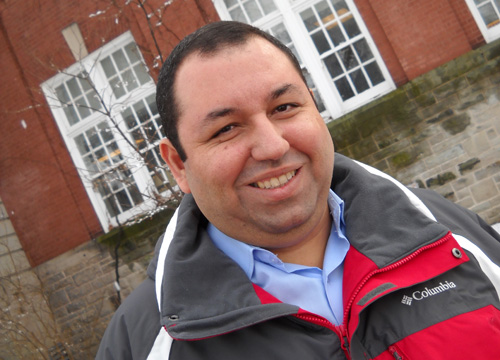
Detecting cancer in medical images. Finding patterns in genetic sequences. Recognizing speech or handwriting. They’re all tasks that computers can do – to a point. Helping to improve machines’ ability to do these and other jobs is the purpose of a new mathematical model developed by a U of G graduate student.
This semester El Sayed Mahmoud will defend his PhD in the School of Computer Science. Working with Prof. Dave Calvert, he’s designed a model to help machines learn better – a crucial skill as we look to computers to help with such varied tasks as evaluating someone’s credit or tracing disease outbreaks.
Varied tasks – but they have something in common, he says. They’re problems that require the machine to find patterns: speech rhythms or common phrases in your speech, for instance, or trends in stock market data.
Right now, computers can be trained to perform many of these functions. But what’s needed, says Mahmoud, are devices that can go beyond their training to handle new information. For computer scientists, that ability is “robustness.”
Suppose you’re voting for a candidate in an election, says Mahmoud. Robustness would measure your candidate’s ability to go beyond campaign promises – their “training ground” – and make sound decisions in the unpredictable world of elected office.
“When you elect an MP, you want to guarantee robustness. They make proper decisions in future, not now – that’s what I mean by robustness.”
Your computer might recognize a voice nine times out of 10 in training. But its performance might drop by two-thirds in the real world of mispronounced words or poor enunciation. “We need to close that gap.”
He says other systems are often based on trying to remove data errors. Using publicly accessible data sets, he took a different approach to look at data fitness.
His system outperformed almost a dozen others in several tasks, including spotting cancer in medical images, recognizing handwritten letters, evaluating a person’s credit, and recognizing nasal and oral vowels in speech.
Ultimately, he hopes his work might help experts train machines to help in finding patterns and making decisions – although not necessarily to replace those experts outright. An animal scientist or breeder might use a computer model to help pinpoint livestock that produce more milk, for example, or meat with less feed.
In another example, Calvert has used computing to help researchers in the Ontario Veterinary College analyze gait data to infer the condition of horses. Elsewhere, he says, machine-learning might help computers tease out patterns in over-the-counter drug sales, emergency-room visits or telehealth calls to spot human infection trends. Referring to drugstore purchases in 2000 in Walkerton, Ont., that presaged the town’s drinking water tragedy, Calvert says, “The pharmacists knew something was up.”
Mahmoud completed his master’s degree at Guelph in 2008. He studied computer engineering, including artificial intelligence and pattern recognition, for his undergrad at Ain Shams University in Egypt.